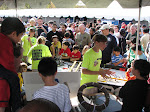This Week's Topic: Robot Performance Consistency
Dear Inventioneers,
Our robot missions will work 5 times in a row one day and then the next day will not work! It is very frustrating to us. How can we get our robot to perform more consistently?
Compiled from multiple teams from NH, VA and CA.
Dear Teams,
Robot reliability is a challenge every team faces - both veteran and rookie. It's one of the reasons coaches are tempted to provide too much "help" to the team - it can be so frustrating. There is only one secret to reliability. Here it is . . . . . landmarks.
Landmarks you say? Yes, effective use of landmarks is the key to robot reliability. Why? Because every game table is built a little differently (see past post), mat surfaces can vary, can be worn in some places, knots and bumps can be present under the mat or along the walls. The only things that stay the same from playing field to playing field are the landmarks. What are landmarks? Here's a list:
lines and graphics on the mat
field elements
walls (especially the South wall)
any object your robot places on the playing field as a landmark
some retrievables and/or deliverables
Some landmarks can be used without sensors - running along walls for example. Most of the other landmarks can be detected through the use of sensors - touch and light and sometimes ultrasonic. Using a wide bumper for touch sensor activation can give your robot a wider margin of error, following lines whenever possible can put your robot in the same vicinity every time, touching the field elements as a reference can help your robot know where it is. Rotations can be accurate enough to get your robot in a general area but to have it know where it is, sensors are the key.
Most rookie teams start out using dead reckoning and rotations. That's fine and teams can rack up a good number of points that way. But to really have confidence that your robot will perform the same way every time, maximize your use of landmarks.
Many teams have their robot bring things out onto the field to help the robot line itself up with a landmark. This can be a great idea if the available landmarks in that area won't help with your particular mission strategy. Sometimes if you are delivering a game piece in a "box" or other container, that element can help your robot align itself or activate a touch sensor.
Using hardware to align your robot out on the playing field is a technique that can work when there are no graphics on the mat to follow. A hardware extension or runner that can find a landmark and orient your robot can be a simple fix for a navigation challenge.
Dear Inventioneers,
Our robot missions will work 5 times in a row one day and then the next day will not work! It is very frustrating to us. How can we get our robot to perform more consistently?
Compiled from multiple teams from NH, VA and CA.
Dear Teams,
Robot reliability is a challenge every team faces - both veteran and rookie. It's one of the reasons coaches are tempted to provide too much "help" to the team - it can be so frustrating. There is only one secret to reliability. Here it is . . . . . landmarks.
Landmarks you say? Yes, effective use of landmarks is the key to robot reliability. Why? Because every game table is built a little differently (see past post), mat surfaces can vary, can be worn in some places, knots and bumps can be present under the mat or along the walls. The only things that stay the same from playing field to playing field are the landmarks. What are landmarks? Here's a list:
lines and graphics on the mat
field elements
walls (especially the South wall)
any object your robot places on the playing field as a landmark
some retrievables and/or deliverables
Some landmarks can be used without sensors - running along walls for example. Most of the other landmarks can be detected through the use of sensors - touch and light and sometimes ultrasonic. Using a wide bumper for touch sensor activation can give your robot a wider margin of error, following lines whenever possible can put your robot in the same vicinity every time, touching the field elements as a reference can help your robot know where it is. Rotations can be accurate enough to get your robot in a general area but to have it know where it is, sensors are the key.
Most rookie teams start out using dead reckoning and rotations. That's fine and teams can rack up a good number of points that way. But to really have confidence that your robot will perform the same way every time, maximize your use of landmarks.
Many teams have their robot bring things out onto the field to help the robot line itself up with a landmark. This can be a great idea if the available landmarks in that area won't help with your particular mission strategy. Sometimes if you are delivering a game piece in a "box" or other container, that element can help your robot align itself or activate a touch sensor.
Using hardware to align your robot out on the playing field is a technique that can work when there are no graphics on the mat to follow. A hardware extension or runner that can find a landmark and orient your robot can be a simple fix for a navigation challenge.
Hope this helps!
The Inventioneers






